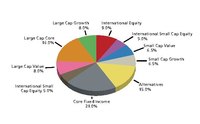
Photo from wikipedia
Abstract It is documented in the literature that due to estimation errors, mean-variance efficient portfolios deliver no higher out-of-sample Sharpe ratios than does the naive equally-weighted portfolio (EWP). This paper… Click to show full abstract
Abstract It is documented in the literature that due to estimation errors, mean-variance efficient portfolios deliver no higher out-of-sample Sharpe ratios than does the naive equally-weighted portfolio (EWP). This paper demonstrates how the out-of-sample performance of the minimum-variance portfolio (MVP) can be improved in the presence of estimation errors by combining the MVP and EWP. Our results indicate that an appropriate combination of the MVP and EWP can enhance Sharpe ratios under any scenarios considered, and can also reduce the portfolio risk if short-selling is allowed. However, the combination strategy is not able to generate a lower risk level than the MVP when a short-selling restriction is imposed. We find that the optimal combination coefficient depends on the factors that greatly impact estimation errors in the MVP, including sample size, estimation method, no-short-selling restriction, and length of the out-of-sample period under consideration.
Journal Title: Economic Modelling
Year Published: 2019
Link to full text (if available)
Share on Social Media: Sign Up to like & get
recommendations!